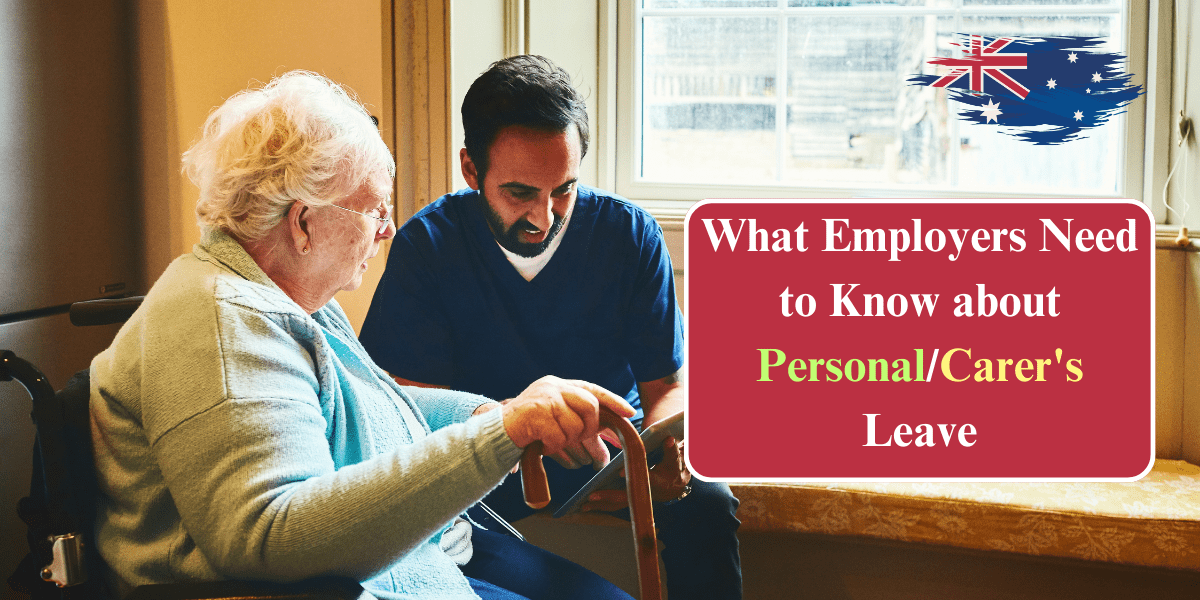As a business owner, you recognize that a healthy and dedicated workforce is crucial for your success. Life happens, and employees sometimes need time off for their health or to care for loved ones.
The National Employment Standards (NES) outline guidelines for personal and carer’s leave (also known as sick leave), supporting employees in these situations and reducing the stress of lost income during recovery or caregiving.
Table of Contents
What is the Employee’s personal and carer’s leave?
Personal leave, or sick leave, allows employees to take paid time off when they are unable to work due to illness or injury. This includes both physical and mental health issues, as well as pregnancy-related illnesses. Employees can use personal leave for medical appointments, ongoing health management, or recovery from unexpected health events.
Carer’s leave enables employees to take time off to care for immediate family members or household members who are unwell, injured, or facing an emergency. This leave acknowledges the critical role employees play in supporting their loved ones during challenging times.
Employees, whether they work full-time or part-time, earn paid personal and carer’s leave based on how many hours they work. Casual employees, while not entitled to paid leave, can take unpaid carer’s leave when necessary to support loved ones.
| Employees Penalty Rates |
| What is Leave Loading? |
| Australia Youth Allowance Rates |
| SCHADS Award Rates |
| Australia Public Holidays 2024 |
Personal and carer’s leave entitlements
The NES provides guidelines on the amount of personal and carer’s leave employees are entitled to and how it accumulates.
Full-time employees receive 10 days of paid personal and carer’s leave annually. Part-time employees accrue leave proportionally to their working hours. Unused leave rolls over from year to year, creating a safety net for future health needs or caregiving responsibilities.
Part-time leave is often calculated as 1/26th of a full-time employee’s leave for each year of service. For guidance, contact our 24/7 Employer Assist Line at 1300 144 002.
While the NES sets minimum standards, some modern awards or enterprise agreements may offer additional benefits. Familiarize yourself with any specific rules applicable to your business.
When companies can ask for proof of personal and carer’s leave
Australian workplace laws balance employee rights with the need for businesses to prevent leave misuse. Employers can request reasonable evidence to ensure leave is used appropriately.
Employers may ask for proof that an employee needs time off for illness or to care for a family member. Acceptable evidence includes:
- Medical certificates from registered health practitioners.
- Statutory declarations affirming the employee was unwell or providing essential care.
The evidence must be reasonable and sufficient to convince a reasonable person that the leave was legitimate. Factors like the duration of the leave and the nature of the illness or emergency should be considered.
Employees must notify their employer as soon as possible if they need to take sick or carer’s leave and indicate the expected duration of their absence.
Understanding carer’s leave situations
Carer’s leave supports employees caring for immediate family or household members during illness or emergencies. Immediate family includes:
- Spouse and de facto partner
- Former spouse and de facto partner
- Children (including adopted, step, or foster children)
- Parents, grandparents, grandchildren, siblings
- The same relatives of an employee’s spouse or de facto partner
- Step-relations and adoptive relations
Carer’s leave also covers emergencies requiring immediate attention, such as picking up a sick child from school or addressing a household crisis.
Evaluate each carer’s leave request individually, considering the illness, injury, or emergency details and the anticipated absence duration. Maintain open and empathetic communication with the employee.
Pay during personal or carer’s leave
Australian law ensures fair compensation for employees during sick or carer’s leave. Pay is based on the employee’s base pay rate, excluding overtime, bonuses, allowances, penalty rates, and incentive-based payments.
Compassionate leave, available for the passing of an immediate family member or severe household emergency, is also paid at the base pay rate.
Employees are compensated for the hours they would typically have worked during their absence. For partial day absences, deduct the corresponding number of hours from their leave balance.
Review modern awards, registered agreements, or employment contracts for any additional benefits beyond the legal minimum.
When leave runs out – options and obligations
Australian law provides unpaid carer’s leave rights when paid leave is exhausted. All employees, including casuals, can access 2 days of unpaid carer’s leave per occasion of illness, injury, or emergency involving immediate family or household members. Full-time and part-time employees can use unpaid carer’s leave only when paid leave is depleted.
For extended absences due to prolonged illness or injury, understand the rights and protections in place. Employees are protected against dismissal for up to 3 months of paid leave use within a year. Consider other leave types, such as accrued annual or long service leave, when personal/carer’s leave is exhausted.
Accumulating and cashing out leave
Sick and carer’s leave begins accumulating from the first workday, even during probation. It continues to accumulate during paid leave and community service but not during unpaid leave. Unused leave rolls over to the next year.
Compassionate leave does not accumulate but provides 2 days per occasion of immediate family or household member death or life-threatening illness or injury. Compassionate leave does not affect other leave balances and has no annual maximum.
Unused sick and carer’s leave cannot be cashed out upon job termination, so employees should take leave when needed.
| Have a workplace problem? If you’re facing an issue at work, know that problems can arise in any workplace. We offer tools and information to help you resolve these issues. Explore “Fixing a Workplace Problem” section for practical guidance on: 1. Identifying if there is a problem 2. Communicating with your employer or employee to address the issue 3. Getting assistance from us if the problem can’t be resolved independently |
FAQs
Is an employee limited to using personal leave only for their illness?
No, personal/carer’s leave covers both an employee’s illness and the need to care for immediate family members who are ill or experiencing an emergency.
How can employers manage suspected misuse of personal/sick leave?
Employers can request evidence (like a medical certificate), implement clear workplace leave policies, and foster open communication to encourage legitimate leave use.
Can employees use carer’s leave for extended paternity leave?
No, the carer’s leave is for short-term illness or emergencies. Refer employees to information on government-funded Parental Leave Pay and any additional workplace entitlements for extended paternity leave.
Can employers offer annual leave instead of unpaid carer’s leave?
Yes, employers can be flexible, ensuring consistency across the workforce and compliance with existing policies and agreements to avoid discrimination claims.
Can employers always demand proof for a single day of absence?
While employers can request evidence, it is advisable to be reasonable for short-term absences. Clearly defined workplace policies regarding evidence requirements can help.




